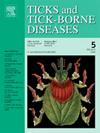Calf immunization protocols with low-virulence isolates of Anaplasma marginale: Analysis of post-inoculation effects and protection against natural challenge
IF 3.1
2区 医学
Q2 INFECTIOUS DISEASES
引用次数: 0
Abstract
Bovine anaplasmosis is endemic and is of fundamental importance worldwide. Therefore, measures for controlling and preventing clinical diseases are warranted to ensure the reduction of associated economic losses. The objective of the present study was to assess the post-inoculation effects and protection conferred by three different protocols of inoculation of low-virulence live strains of Anaplasma marginale (UFMG1 and UFMG3) in field-challenged cattle. Sixty-eight Holstein calves with an average age of 17 days were randomly divided into four groups. The groups received two subcutaneous administrations spaced 40 days apart, at a dosage of 2 × 106 infected erythrocytes of the following A. marginale strains: G1 (UFMG1 + UFMG1); G2 (UFMG3 + UFMG3); G3 (UFMG1 + UFMG3); and G4 (control). Every two days, the animals were evaluated for rectal temperature, Packed Cell Volume (PCV), and blood smears. Blood samples were collected prior to inoculation, before the field challenge, and after the challenge period, nPCR and IFAT techniques were performed. There were no significant differences in rickettsemia levels, reduction in PCV, or antibody detection among the different inoculation strategies. Forty days after the second inoculation, 90 %, 84.6 %, and 90.9 % of the animals in G1, G2, and G3, respectively, tested positive using nPCR. After inoculation, the group G2, which received the UFMG3 inoculum, had a higher frequency of treatment (odds ratio of 6.7; 1.198-38.018 CI; p = 0.03), while groups G1 and G3 demonstrated similar treatment frequencies compared to the control. During the natural challenge phase, 13.3 % of animals in group G1 required treatment (odds ratio of 0.108; 0.018-0.635 CI; p = 0.014) compared to 58.8 % of the control group. Considering the results collectively, the protocol using the UFMG1 strain (G1) stands out for its potential to be safe and induce some degree of immunization against A. marginale, reducing the incidence of clinical disease and the need for treatment during natural challenge.
用低毒性边位阿纳疟原虫分离物对犊牛进行免疫的方案:接种后效果和对自然挑战的保护分析。
牛无形体病是一种地方病,在世界范围内具有重要意义。因此,必须采取措施控制和预防临床疾病,以确保减少相关的经济损失。本研究的目的是评估三种不同方案接种低毒性边形体弓形虫活菌株(UFMG1 和 UFMG3)对田间挑战牛的接种后效果和保护作用。68 头平均年龄为 17 天的荷斯坦小牛被随机分为四组。各组接受两次皮下注射,每次间隔 40 天,剂量为 2 × 106 个受感染的红细胞,分别为以下 A. marginale 株系:G1(UFMG1 + UFMG1);G2(UFMG3 + UFMG3);G3(UFMG1 + UFMG3);G4(对照组)。每两天对动物进行一次直肠温度、包装细胞体积(PCV)和血液涂片评估。在接种前、野外挑战前和挑战期结束后采集血液样本,并进行 nPCR 和 IFAT 技术检测。不同的接种策略在立克次体血症水平、PCV 降低或抗体检测方面没有明显差异。第二次接种 40 天后,G1、G2 和 G3 组分别有 90%、84.6% 和 90.9%的动物在 nPCR 检测中呈阳性。接种后,接受 UFMG3 接种物的 G2 组的治疗频率更高(几率比为 6.7;1.198-38.018 CI;p = 0.03),而 G1 和 G3 组的治疗频率与对照组相似。在自然挑战阶段,G1 组有 13.3% 的动物需要治疗(几率比为 0.108;0.018-0.635 CI;p = 0.014),而对照组则为 58.8%。综合上述结果,使用 UFMG1 株系(G1)的方案因其潜在的安全性和诱导一定程度的马立克氏疟原虫免疫而脱颖而出,从而降低了临床疾病的发病率和自然挑战期间的治疗需求。
本文章由计算机程序翻译,如有差异,请以英文原文为准。
求助全文
约1分钟内获得全文
求助全文
来源期刊

Ticks and Tick-borne Diseases
INFECTIOUS DISEASES-MICROBIOLOGY
CiteScore
6.90
自引率
12.50%
发文量
185
审稿时长
6-12 weeks
期刊介绍:
Ticks and Tick-borne Diseases is an international, peer-reviewed scientific journal. It publishes original research papers, short communications, state-of-the-art mini-reviews, letters to the editor, clinical-case studies, announcements of pertinent international meetings, and editorials.
The journal covers a broad spectrum and brings together various disciplines, for example, zoology, microbiology, molecular biology, genetics, mathematical modelling, veterinary and human medicine. Multidisciplinary approaches and the use of conventional and novel methods/methodologies (in the field and in the laboratory) are crucial for deeper understanding of the natural processes and human behaviour/activities that result in human or animal diseases and in economic effects of ticks and tick-borne pathogens. Such understanding is essential for management of tick populations and tick-borne diseases in an effective and environmentally acceptable manner.
 求助内容:
求助内容: 应助结果提醒方式:
应助结果提醒方式:


